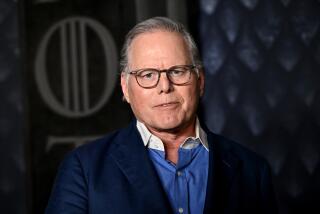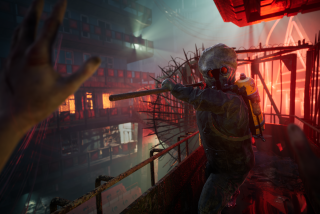Warner’s approach to video games is paying off
- Share via
“The Dark Knight Rises” doesn’t hit movie theaters for nine months, but Batman is at the heart of what may just be Warner Bros.’ most important release of the fall.
With the launch Tuesday of video game Arkham City, a sequel to 2009 hit Arkham Asylum that lets players control the Caped Crusader, the studio’s Warner Bros. Interactive Entertainment unit has one of the best-reviewed and most anticipated titles of the year. It’s expected to generate hundreds of millions of dollars in sales.
For video game industry veterans it’s a surprising place to find a Hollywood studio, given the industry’s faltering attempts to crack the $65-billion global video game market. Nearly every other major entertainment company, including Walt Disney Co., News Corp., Universal Studios and Viacom Inc., has retrenched from or exited the video game business in the last decade after losing money.
Warner has prospered recently by following a different course. It spent hundreds of millions to acquire and expand video game franchises not tied to individual films, including fighting series Mortal Kombat, games based on Lego toys and the Batman Arkham series. These investments have given Hollywood’s biggest movie studio several of the hottest brands in the video game industry.
“What we have in common with our movie counterparts is that we’re following a tent-pole strategy,” said Martin Tremblay, an industry veteran named president of Warner Interactive in 2008. “We’re making the serious investments it takes to build franchises, and we don’t just want to release good games, we want to be sure that we make a statement.”
Warner Interactive has about 1,800 employees and typically spends $30 million to $40 million to make its games. The unit expects to have its most profitable year in 2011 and is on track to generate close to $1 billion in sales, Tremblay said. That’s tiny compared with the $4.8 billion in box office the studio’s motion pictures generated last year and barely a blip for parent company Time Warner Inc., but it’s still significant.
“All the media companies have at one point or another looked to games for growth, but right now Warner is the only one doing anything right,” Wedbush Morgan Securities analyst Michael Pachter said.
Warner Interactive’s first game, a 2005 World of Warcraft-like online title based on the sci-fi film “The Matrix,” was a costly flop. The division struggled to find a hit for several years, but Warner home entertainment group President Kevin Tsujihara, Tremblay’s boss and the driver of the studio’s video game strategy, remained undeterred. With a DVD distribution operation that could add games at little cost and a library of well-known characters, he believed Warner possessed two of three factors needed for success.
“We already had competitive advantages,” Tsujihara said. “But we didn’t have the ability to make games.”
To get there, Tsujihara went on a spending spree, buying five game production companies and founding another over the last four years. Warner Interactive’s biggest franchises — Lego, Mortal Kombat and Arkham — were acquired along with the development teams that make the games.
Warner Interactive spent more than $200 million to buy Lego games maker Traveller’s Tales in 2007. Its games, including Lego Batman and Lego Harry Potter, perennially rank among the industry’s top 10. Traveller’s Tales’ success is the primary reason Warner Interactive was profitable from 2008 to 2010, Tremblay said.
Midway Games, the 23 year-old company behind classic arcade titles like Mortal Kombat and Joust, was bought out of bankruptcy in 2009 for $33 million. With it, Warner is seeking to rejuvenate a company that nearly died under its former owner, media mogul Sumner Redstone.
“We were in this building with leaky roofs and power problems, and the first thing Warner did was to move us to a new location with state-of-the-art technology,” Mortal Kombat creator Ed Boon said. The ninth Mortal Kombat game, the first released by Warner, was launched in April. It has sold more than 3 million units and made the Midway acquisition profitable.
Warner Interactive has had its share of failures, including June’s action-horror game F.E.A.R. 3. A Green Lantern game released in June also flopped and may be the last the studio releases alongside one of its films, save for kids’ titles such as November’s Happy Feet 2.
Games closely tied to movies were once the bread and butter of Hollywood studios but have fallen out of favor. Though they benefit a film’s marketing dollars, these titles often are rushed to meet a release date and fail to meet the level of quality that players demand.
“The movie-based games business is broken, and for teen-targeted titles, we’re going to try and distance ourselves from the movies so the game stands by itself,” Tremblay said.
That’s the strategy that appears likely to make Arkham City a blockbuster. Compilation site Metacritic ranks it as the best-reviewed video game so far in 2011, and interest among gamers is twice as high as it was ahead of release for predecessor Arkham Asylum, which sold 4.3 million copies, according to research firm Ipsos OTX. Each sale will mean larger profits for Warner Interactive than on the original, because Warner it did not own developer Rocksteady at the time and co-published the game with another company.
In Arkham City, players control Batman and Catwoman while navigating a section of Gotham City filled with villains such as the Joker, the Riddler and Mr. Freeze. “It’s been a massive challenge building a natural urban environment for Batman,” Rocksteady director Jamie Walker said. “We expanded from 75 to more than 100 people.”
Warner will launch a new Lord of the Rings game in November and a Hobbit title in 2012 before Peter Jackson’s movie “The Hobbit: An Unexpected Journey” comes out that December. The game is one of the studio’s top releases for next year, along with a Lego Batman sequel and a game featuring a superhero from Warner’s DC Comics unit that Tremblay wouldn’t name. The company also is targeting younger players with a second Lego Harry Potter in November and casual online games based on Warner characters being made at a new development studio in Montreal.
Building a stronger online presence is the company’s most critical challenge, as sales of traditional disc games have fallen 16% in the last two years, according to the NPD Group. Tremblay’s goal is that by 2015, 30% of Warner’s revenue will come from digital distribution.
But unlike competitors such as Disney, which paid $563 million for social games maker Playdom last year and has racked up losses since, Warner is moving cautiously on the Internet, cellphones and Facebook. It’s betting that consoles like the PlayStation and Wii have more life left than some in the industry believe.
“I don’t want to say we are ignoring things like social and mobile,” Tremblay said. “But our DNA as Warner Bros. is still where most of the video game business is today.”
Times staff writer Alex Pham contributed to this report.
More to Read
The biggest entertainment stories
Get our big stories about Hollywood, film, television, music, arts, culture and more right in your inbox as soon as they publish.
You may occasionally receive promotional content from the Los Angeles Times.










